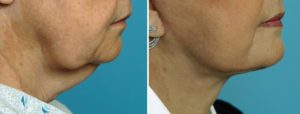The plastic surgery treatment of the aging face often involves a facelifting surgery. A facelift is one of the top ten cosmetic procedures performed in the United States. Despite its frequent performance and its recognition by the public, it is a procedure that is usually misunderstood.

Another misconception about facelifts is what is actually lifted. Everyone understands that face and neck skin is lifted and moved back, but what goes on underneath the skin layer is a frequent point of misinterpretation. Patients often ask me if I am going to lift and tighten the ‘muscles’. From an anatomic standpoint, lifting the facial muscles is an impossibility. Most facial muscles are attached tightly to the underlying bone and moving them would not only be very difficult but would not have any postive benefit. There is only one muscle that is often tightened in a facelift and that is the platysma muscle in the neck, which is often separated due to aging. It is never lifted per se but it is tightened in the middle, from the chin down to the adam’s apple, to help sharpen the neck angle.
The layer underneath the skin that patients misinterpret as muscle being moved is actually a different tissue altogether. Between the skin and the muscles is a layer of tissue known as the SMAS. This is an acronym for a more anatomic name but for simplicity of understanding think of the SMAS as another layer of skin underneath. This layer can be raised up off the muscles and resuspended up higher on the face. The combination of SMAS and skin tightening together generally makes for a better facelift result that may last somewhat longer.
There is great controversy in plastic surgery about how to most effectively deal with the SMAS during the facelift operation. Many facelift surgeons tout their own techniques and may even have their own names for their ‘type’ of facelift based on their version of SMAS manipulation. While SMAS management in any form of a facelift is a plus, there is no proven superior method of what to do with it. If one single SMAS facelift technique was genuinely best, we all would be using it.
In a facelift, the underlying tissues that are manipulated is the SMAS layer not muscles. SMAS tightening does usually make for a better facelift result that is more durable. However, time and aging will eventually outlast any facelift result no matter how it is done. And the overall goal for most patients is to ultimately outlive their facelift result….or at least I would think so.
Dr. Barry Eppley
Indianapolis, Indiana


